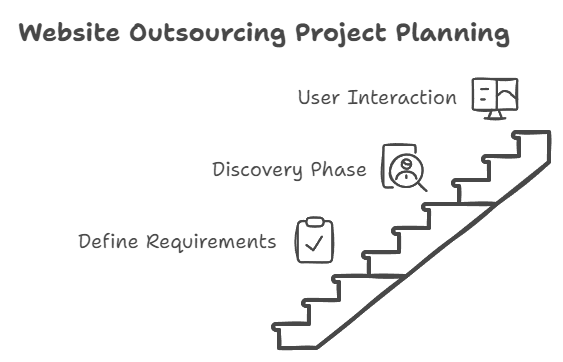What Is Website Outsourcing?
September 17th, 2024

What Is Website Outsourcing?
When you think about website outsourcing, you're considering the practice of hiring external experts to handle your web development needs. This can free up your in-house team and provide access to specialized skills that might not be available internally. You might wonder about the different models of outsourcing, the benefits it can bring, and the potential pitfalls to watch out for. Understanding these elements could be crucial for your business strategy, especially when you consider the various ways to make outsourcing work effectively. What factors should you prioritize to ensure a successful partnership?
Definition of Website Outsourcing
When businesses need specialized web development skills, they often turn to website outsourcing. This practice involves hiring external vendors or agencies to handle web development tasks, letting you access the expertise your team may lack.
There are different forms of outsourcing, such as full outsourcing, dedicated teams, and staff augmentation. Each option varies in management control and team integration.
Outsourcing can offer significant benefits:
- Cost Efficiency: You can save money since projects can range from $5,000 for basic websites to $400,000 for complex solutions.
- Faster Project Delivery: With dedicated web development teams, you can speed up timelines.
- Scalability: You can easily adjust resources based on demand.
Of course it depends who you pick to help with your website. For example, Clixoni don't charge an upfront fee, a new website is included with every brand building package, which saves you thousands each month by providing you with a website, content marketing, and a sales and marketing CRM.
However, you should also be aware of potential challenges. Communication barriers, quality control issues, and cultural differences can arise with offshore outsourcing.
Effective project management and clear expectations are crucial to overcoming these obstacles. The choice of outsourcing provider and location—nearshore, offshore, or onshore—affects costs, communication ease, and overall project success.
Embracing website outsourcing can be a smart move if you navigate these factors wisely.

Types of Outsourcing Models
When it comes to outsourcing your website development, you've got a few key models to consider.
The Full Outsourcing Model means a vendor takes care of everything with little input needed from you.
If you prefer more collaboration, the Dedicated Team Approach might be right, while the Staff Augmentation Strategy lets you bring in extra hands but requires you to manage them completely.

Full Outsourcing Model
How can a business maximize efficiency and minimize management hassles? One effective way is by adopting the full outsourcing model for your web development project. In this approach, a vendor's self-managed team takes complete responsibility, allowing you to focus on your core business functions.
With the full outsourcing model, you can leverage the vendor's expertise and specialized skills, such as software architecture, UX/UI design, and quality assurance. This not only speeds up project delivery but also reduces operational overhead. You won't have to worry about hiring in-house talent for every technical aspect.
However, it's crucial to select reputable partners. While the benefits can be significant, challenges like communication barriers and reliance on the vendor's performance can arise.
To ensure a smooth collaboration, maintain open lines of communication and set clear expectations from the start.
Dedicated Team Approach
While the full outsourcing model offers significant advantages, the dedicated team approach provides an alternative that can enhance collaboration and project oversight. In this model, a vendor supplies a specialized team that focuses solely on your project. This setup fosters consistent communication, helping you stay in the loop.
Here's what a dedicated team typically includes:
- Project Managers: They coordinate tasks and ensure everything runs smoothly.
- Developers: These experts build your website with the latest technologies.
- UX/UI Designers: They create user-friendly interfaces that attract visitors.
- QA Specialists: They test everything to catch issues before launch.
This approach is especially beneficial for long-term projects, where understanding your business goals is key.
You'll receive regular updates and progress reports, allowing you to maintain oversight throughout the development process.
With a dedicated team, you access specialized skills without the overhead costs of hiring full-time staff.
Staff Augmentation Strategy
Staff augmentation is a highly effective strategy that allows companies to seamlessly integrate remote professionals into their existing teams. This flexible outsourcing model means you can hire specialized roles, like developers or designers, for a set period.
With the right tools, such as comprehensive CRM solutions, it helps your internal teams manage projects more efficiently, giving you greater control over project management and resource allocation.
Here's how it works:
- Management Responsibility: Unlike full outsourcing, you maintain full oversight, ensuring alignment with your goals.
- Access to Expertise: You gain specialized skills that mightn't be available in-house, helping you meet tight deadlines.
- Cost Savings: Hourly rates for augmented staff typically range from $20 to $100, which can lead to significant savings compared to traditional hiring.
When your projects demand extra hands, staff augmentation can be the answer. It allows you to quickly scale your workforce without long-term commitments.
Benefits of Outsourcing
Outsourcing web development often brings a multitude of benefits that can transform your business operations. By choosing to outsource web development, you can significantly reduce operational costs. Projects usually range from $5,000 to $100,000, depending on complexity and location. This means more budget flexibility for other important areas.
Moreover, comprehensive tools available for business scaling can be integrated into your operations, amplifying the positive impact of outsourcing.
You gain access to specialized skills that may not be available in-house. This allows you to leverage the latest technologies, ensuring quality work on your projects.
Outsourcing also helps you focus on your core business activities. By handing off non-core functions, you can dedicate more time to strategic initiatives.
Additionally, the flexibility of outsourcing lets you scale your operations based on project demands. You can quickly adjust team size and resources without the commitment of hiring full-time employees.
This adaptability leads to improved efficiency and productivity.
Challenges of Outsourcing
Although outsourcing web development offers numerous advantages, it also comes with its own set of challenges that can impact the success of your projects. Understanding these outsourcing challenges is crucial to navigate potential pitfalls effectively.
Here are some common issues you might face:
- Communication barriers: Misunderstandings can arise, especially when teams work in different time zones or speak different languages.
- Quality control: If project standards aren't clearly defined, you may encounter quality issues that could derail your project.
- Project oversight: Relying on external teams can complicate management, leading to project delays and misalignment with your business goals.
- Cultural differences: Variations in work styles and expectations can create conflicts, affecting collaboration and workflow efficiency.
- Intellectual property: Working with external vendors heightens the risk of sensitive information leaks, making it essential to implement strict security measures.
Project Planning and Discovery
When you're planning a website outsourcing project, it's crucial to define your project requirements right from the start.
The discovery phase is important because it helps you understand your business needs and how users will interact with your site.

Defining Project Requirements
Defining project requirements is a crucial step that sets the stage for successful website development. You want to ensure you clearly outline your project goals, identify your target audience, and specify the functionalities needed. This way, you can guide the development process effectively.
Additionally, leveraging tools for project management centralization can enhance team collaboration and streamline communication throughout the project.
To achieve this, consider the following key activities:
- Hold stakeholder workshops to gather diverse input and expectations.
- Create user stories to clarify how users will interact with your product.
- Develop a Software Requirements Specification (SRS) that details both functional and non-functional requirements.
- Identify technical requirements that align with your project goals.
- Establish a development plan that includes quality assurance measures to keep everything on track.
Through these steps, you're defining your project and ensuring everyone involved understands the vision. This foundation not only enhances usability but also ensures the project aligns with the initial objectives.
Discovery Phase Importance
In the realm of website development, the discovery phase plays a pivotal role in shaping the project's success. This phase typically accounts for 20-30% of the overall timeline, allowing you to dive deep into analysis and planning.
It's your chance to understand major business needs, like improving communication or systemizing data, ensuring your project goals align with organizational objectives.
Here's what you should focus on during the discovery phase:
- Identify target users: Knowing who'll use your website helps inform design and functionality, enhancing user experience.
- Define functionality: Establish high-level functional and technical requirements to clarify the project scope.
- Conduct a feasibility study: Assess the project's viability with an ROI analysis to understand financial implications.
User Experience Considerations
User experience (UX) considerations are crucial during project planning and discovery, as they directly impact how users interact with your website.
You want your audience to feel welcomed and understood, so focusing on their needs is key. Here are some important aspects to keep in mind:
- Conduct stakeholder workshops to gather diverse input on user experience expectations.
- Create user stories or personas to tailor functionalities based on specific user needs.
- Define high-level functional and technical requirements that ensure scalability for future growth.
- Focus on user engagement to keep visitors coming back and interacting with your site.
- Perform competitor analysis to learn effective UX practices and features that work well.
Cost Considerations and Technologies
Considering the various factors influencing web development costs, it's crucial to understand how project complexity and geographic location impact your budget. Here's what you need to know:
- Project Complexity: Costs can range from $5,000 for basic websites to $400,000 for complex solutions. More features mean higher costs.
- Geographic Location: Offshore rates, like those in India, start at $15 to $25 per hour. In contrast, skilled developers in the USA may charge $40 to $100 per hour. Choosing the right location can significantly affect your project budget.
- Technology Stack: The programming languages and frameworks you pick play a role in both initial development costs and future maintenance.
- Cloud Services: Using platforms like Microsoft Azure or AWS adds costs based on services used.
- Non-Functional Requirements: Factors such as performance, security, and scalability can increase development costs.
Compliance with industry regulations can also add to your budget.
Frequently Asked Questions
How Do I Outsource My Website?
To outsource your website, outline your design preferences and budget considerations. Research freelance developers, assess proposals, and focus on communication tools. Prioritize project management and quality assurance, ensuring post-launch support and clear contract negotiations for successful vendor selection.
What Are the 4 Types of Outsourcing?
When exploring outsourcing, consider full outsourcing, dedicated team, staff augmentation, and nearshore options. Each offers unique advantages like cost efficiency, quality control, and effective project communication, helping you find the perfect fit for your needs.
How Much Does IT Cost to Outsource a Website?
Outsourcing a website can cost between $1,000 and $50,000, depending on design pricing strategies and development fees comparison. Consider hidden expenses and international outsourcing rates to maximize long-term savings while ensuring quality assurance practices are in place.
What Is the Meaning of Online Outsourcing?
Online outsourcing means leveraging remote teams for project management, offering cost efficiency and skill specialization. You gain time savings while ensuring quality control through effective communication strategies, risk assessment, and careful vendor selection from a global talent pool.
Final Thoughts
In conclusion, website outsourcing can be a smart move for your business if you want to tap into specialized skills while saving time and money. Just remember, it's not all smooth sailing; you'll need to tackle communication and quality control challenges. By planning your project carefully and considering costs, you can set yourself up for success. So, don't put all your eggs in one basket—explore your options and choose the outsourcing model that fits your needs best!